Nitrogen Fertilization Using Conventional and Slow-Release Fertilizers at Multiple Levels in Lolium multiflorum Lam. Pastures
Abstract
:1. Introduction
2. Materials and Methods
2.1. Study Site
2.2. Soils
2.3. Climate Data
2.4. Soil Chemical Analyses
2.5. Experimental Design
2.6. Agricultural Practices
2.7. Productivity Determination and Sample Collection
2.8. Forage Chemical Analyses
2.9. Crude Protein Productivity and Nitrogen Fertilization Use Efficiency
2.10. Determination of Production Costs
2.11. Statistical Analysis
3. Results
3.1. Productivity Analyses
3.2. Forage Chemical Analyses
3.3. Crude Protein Productivity and Nitrogen Fertilization Use Efficiency
3.4. Cost Analysis
4. Discussion
5. Conclusions
Supplementary Materials
Author Contributions
Funding
Data Availability Statement
Acknowledgments
Conflicts of Interest
References
- Givens, D.I.; Deaville, E.R. The Current and Future Role of Near Infrared Reflectance Spectroscopy in Animal Nutrition: A Review. Aust. J. Agric. Res. 1999, 50, 1131–1145. [Google Scholar] [CrossRef]
- Rezaei, J.; Rouzbehan, Y.; Zahedifah, M.; Fazaeli, H. Effects of Dietary Substitution of Maize Silage by Amaranth Silage on Feed Intake, Digestibility, Microbial Nitrogen, Blood Parameters, Milk Production and Nitrogen Retention in Lactating Holstein Cows. Anim. Feed Sci. Technol. 2015, 202, 32–41. [Google Scholar] [CrossRef]
- Wilkins, R.J.; Givens, D.I.; Owen, E.; Axford, R.F.E.; Omed, H.M. Forages and Their Role in Animal Systems. In Forage Evaluation in Ruminant Nutrition; CAB International: Wallingford, UK, 2000; pp. 1–14. [Google Scholar]
- Dale, L.M.; Thewis, A.; Boudry, C.; Rotar, I.; Pacurar, S.F.; Abbas, Q.; Dardenne, P.; Baeten, V.; Pfister, J. Discrimination of Grassland Species and Their Classification in Botanical Families by Laboratory Scale NIR Hyperspectral Imaging: Preliminary Results. Talanta 2013, 116, 149–154. [Google Scholar] [CrossRef]
- Maduro Dias, C.S.A.; Nunes, H.P.B.; Borba, A.E.S. Influence of the Physical Properties of Samples in the Use of NIRS to Predict the Chemical Composition and Gas Production Kinetic Parameters of Corn and Grass Silages. Fermentation 2023, 9, 418. [Google Scholar] [CrossRef]
- Gerrish, J. Management-Intensive Grazing: The Grassroots of Grass Farming; Green Park Press: Ridgeland, MS, USA, 2004. [Google Scholar]
- Crestani, S.; Baade, E.A.S.; Ribeiro Filho, H.M.N. Características Morfogênicas, Estruturais e Padrões de Desfolhação em Pastos de Azevém Anual Durante o Período de Ocupação e em Duas Pressões de Pastejo. In Proceedings of the XVII Congresso de Iniciação Científica e X Encontro de Pós-Graduação; Universidade Federal de Pelotas: Pelotas, Brazil, 2008. [Google Scholar]
- Miltner, E.D.; Stahnke, G.K.; Johnston, W.J.; Golob, C.T. Late Fall and Winter Nitrogen Fertilization of Turfgrass in Two Pacific Northwest Climates. HortScience 2004, 39, 1745–1749. [Google Scholar] [CrossRef]
- Zaman, M.; Zaman, S.; Adhinarayanan, C.; Nguyen, M.L.; Nawaz, S.; Dawar, K.M. Effects of Urease and Nitrification Inhibitors on the Efficient Use of Urea for Pastoral Systems. Soil Sci. Plant Nutr. 2013, 59, 649–659. [Google Scholar] [CrossRef]
- Malinas, A.; Rotar, I.; Vidican, R.; Iuga, V.; Pacurar, F.; Malinas, C.; Moldovan, C. Designing a Sustainable Temporary Grassland System by Monitoring Nitrogen Use Efficiency. Agronomy 2020, 10, 149. [Google Scholar] [CrossRef]
- Abdullah, B.; Niazi, M.B.K.; Jahan, Z.; Khan, O.; Shahid, A.; Shah, G.A.; Azeem, B.; Iqbal, Z.; Mahmood, A. Role of Zinc-Coated Urea Fertilizers in Improving Nitrogen Use Efficiency, Soil Nutritional Status, and Nutrient Use Efficiency of Test Crops. Front. Environ. Sci. 2022, 10, 888865. [Google Scholar] [CrossRef]
- Han, K.J.; Pitman, W.D.; Alison, W.M.; Twidwell, E.K.; Guidry, K.M. Quantification of Slow-Release Fertilizer on Year-Round Forage Production. Agron. J. 2022, 114, 3306–3316. [Google Scholar] [CrossRef]
- Qian, P.; Schoenau, J. Effects of Conventional and Controlled Release Phosphorus Fertilizer on Crop Emergence and Growth Response under Controlled Environment Conditions. J. Plant Nutr. 2010, 33, 1253–1263. [Google Scholar] [CrossRef]
- Cotching, W.E.; Burkitt, L.L. Nitrogen Use Efficiency in Grazing Systems. In Proceedings of the 26th Annual Conference of the Grassland Society of Southern Australia, Hamilton, VIC, Australia, 26–28 July 2011. [Google Scholar]
- Sulewska, H.; Ratajczak, K.; Roszkiewicz, R. Assessment of the Impact of Magnesium and Nitrogen Fertilization on Two Species of Grasses Used as Horse Feed. Agronomy 2024, 14, 1086. [Google Scholar] [CrossRef]
- Cherney, J.H.; Cherney, D.J.R. Grass for Dairy Cattle; CABI Publishing: Wallingford, UK, 1998; Volume 33–93, pp. 223–241. [Google Scholar]
- Pavinato, P.S.; Restelatto, R.; Sartor, L.R.; Paris, W. Production and Nutritive Value of Ryegrass (cv. Barjumbo) Under Nitrogen Fertilization. Rev. Ciência Agronômica 2014, 45, 230–237. [Google Scholar] [CrossRef]
- Delevatti, L.M.; Cardoso, A.S.; Barbero, R.P.; Leite, R.G.; Romanzini, E.P.; Ruggieri, A.C.; Reis, R.A. Effect of nitrogen application rate on yield, forage quality, and animal performance in a tropical pasture. Sci. Rep. 2019, 20, 7596. [Google Scholar] [CrossRef]
- Cinar, S.; Ozkurt, M.; Cetin, R. Effects of Nitrogen Fertilization Rates on Forage Yield and Quality of Annual Ryegrass. Appl. Ecol. Environ. Res. 2020, 18, 417–432. [Google Scholar] [CrossRef]
- Godlewska, A.; Ciepiela, G.A. Italian Ryegrass (Lolium multiflorum Lam.) Fiber Fraction Content and Dry Matter Digestibility Following Biostimulant Application Against the Background of Varied Nitrogen Regime. Agronomy 2021, 11, 39. [Google Scholar] [CrossRef]
- Thomason, W.E.; Raun, W.R.; Johnson, G.V. Winter Wheat Fertilizer Nitrogen Use Efficiency in Grain and Forage Production Systems. J. Plant Nutr. 2000, 23, 1505–1516. [Google Scholar] [CrossRef]
- Silveira, D.C.; Machado, J.M.; Bonetti, L.P.; Carvalho, I.C.; Szareski, V.J.; Barbosa, M.H.; Rosa, T.C.; Schaeffer, A.H.; Minski da Motta, E.A.; Moura, N.B. Influence of nitrogen rates on the persistence of ryegrass (Lolium multiflorum L.) forage production. Aust. J. Crop Sci. 2020, 14, 1549–1554. [Google Scholar] [CrossRef]
- McCartney, D.H.; Lardner, H.A.; Stevenson, F.C. Economics of Backgrounding Calves on Italian Ryegrass (Lolium multiflorum) Pastures in the Aspen Parkland. Can. J. Anim. Sci. 2008, 88, 19–28. [Google Scholar] [CrossRef]
- INE—Instituto Nacional de Estatística. Estatísticas Agrícolas 2023. Available online: https://www.ine.pt/xportal/xmain?xpid=INE&xpgid=ine_publicacoes&PUBLICACOESpub_boui=439500127&PUBLICACOESmodo=2 (accessed on 1 August 2024).
- IAMA—Instituto de Alimentação e Mercados Agrícolas. Portal do Leite e Lacticínios dos Açores. Available online: https://portaldoleite.azores.gov.pt/Entregas_Leite_Produtores_Total.aspx (accessed on 1 August 2024).
- ARF—Agricultura e Recursos Florestais. Available online: https://rea.azores.gov.pt/reaa/36/agricultura-e-recursos-florestais/707/superficie-agricola-e-florestal (accessed on 20 August 2024).
- Madeira, M.; Pinheiro, J.; Madruga, J.; Monteiro, F. Soils of Volcanic Systems in Portugal. In Soils of Volcanic Regions in Europe; Arnalds, Ó., Óskarsson, H., Bartoli, F., Buurman, P., Stoops, G., García-Rodeja, E., Eds.; Springer: Berlin/Heidelberg, Germany, 2007. [Google Scholar] [CrossRef]
- IPMA—Instituto Português do Mar e da Atmosfera. Fichas Climatológicas 1981–2010. Available online: https://www.ipma.pt/pt/oclima/normais.clima/1981-2010/normalclimate8110.jsp (accessed on 8 July 2024).
- Paredes, P.; Fontes, J.C.; Azevedo, E.B.; Pereira, L.S. Daily Reference Crop Evapotranspiration with Reduced Data Sets in the Humid Environments of Azores Islands Using Estimates of Actual Vapor Pressure, Solar Radiation, and Wind Speed. Theor. Appl. Climatol. 2018, 134, 1115–1133. [Google Scholar] [CrossRef]
- Melo, C.D.; Maduro Dias, C.S.A.M.; Wallon, S.; Borba, A.E.S.; Madruga, J.; Borges, P.A.V.; Ferreira, M.T.; Elias, R.B. Influence of Climate Variability and Soil Fertility on the Forage Quality and Productivity in Azorean Pastures. Agriculture 2022, 12, 358. [Google Scholar] [CrossRef]
- ISO 11260:2018; Soil quality—Determination of Effective Cation Exchange Capacity and Base Saturation Level Using Barium Chloride Solution. International Organization for Standardization: Geneva, Switzerland, 2018.
- AOAC—Association of Official Analytical Chemists. Official Methods of Analysis, 12th ed.; AOAC: Washington, DC, USA, 1999. [Google Scholar]
- Goering, H.K.; Van Soest, P.J. Forage Fiber Analysis (Apparatus, Reagents, Procedures, and Some Applications); Agriculture Handbook 379; ARS, USDA: Washington, DC, USA, 1970. [Google Scholar]
- Walton, P.D. The Production and Management of Cultivated Forages; Reston Publishing Company Inc.: Reston, VA, USA, 1983; p. 336. [Google Scholar]
- Hopkins, C.; Marais, J.P.; Goodenough, D.C.W. A Comparison, Under Controlled Environmental Conditions, of a Lolium multiflorum Selection Bred for High Dry-Matter Content and Non-Structural Carbohydrate Concentration with a Commercial Cultivar. Grass Forage Sci. 2002, 57, 367–372. [Google Scholar] [CrossRef]
- Malcolm, B.J.; Cameron, K.C.; Di, H.J.; Edwards, G.R.; Moir, J.L. The Effect of Four Different Pasture Species Compositions on Nitrate Leaching Losses Under High N Loading. Soil Use Manag. 2015, 30, 58–68. [Google Scholar] [CrossRef]
- Dupas, E.; Buzetti, S.; Rabêlo, F.H.; Sarto, A.L.; Cheng, N.C.; Filho, M.C.; Galindo, F.S.; Dinalli, R.P.; Gazola, R. Nitrogen recovery, use efficiency, dry matter yield, and chemical composition of palisade grass fertilized with nitrogen sources in the Cerrado biome. Aust. J. Crop Sci. 2016, 10, 1330–1338. [Google Scholar] [CrossRef]
- Salama, H.S.A.; Badry, H.H. Influência de Doses Variáveis de Mistura e Doses de Adubação Nitrogenada na Qualidade da Forragem de Trevo Egípcio (Trifolium alexandrinum L.) e Azevém Anual (Lolium multiflorum Lam.). J. Afr. De Pesqui. Agrícola 2015, 10, 4858–4864. [Google Scholar]
- Viana, J. Pastagens e Forragens—Manual do Formador; Secretaria Regional de Agricultura e Florestas: Angra do Heroísmo, Açores, Portugal, 2020; 240p. [Google Scholar]
- Reis, R. Avaliação da Incidência de Puccinia spp. nas Pastagens de Lolium multiflorum Lam. e Lolium perenne L. Bachelor’s Thesis, Universidade dos Açores, Ponta Delgada, Portugal, 2016. [Google Scholar]
- Kee, J.; Cardell, L.; Zereyesus, Y.A. Global Fertilizer Market Challenged by Russia’s Invasion of Ukraine. Available online: https://www.ers.usda.gov/amber-waves/2023/september/global-fertilizer-market-challenged-by-russia-s-invasion-of-ukraine/ (accessed on 15 August 2024).
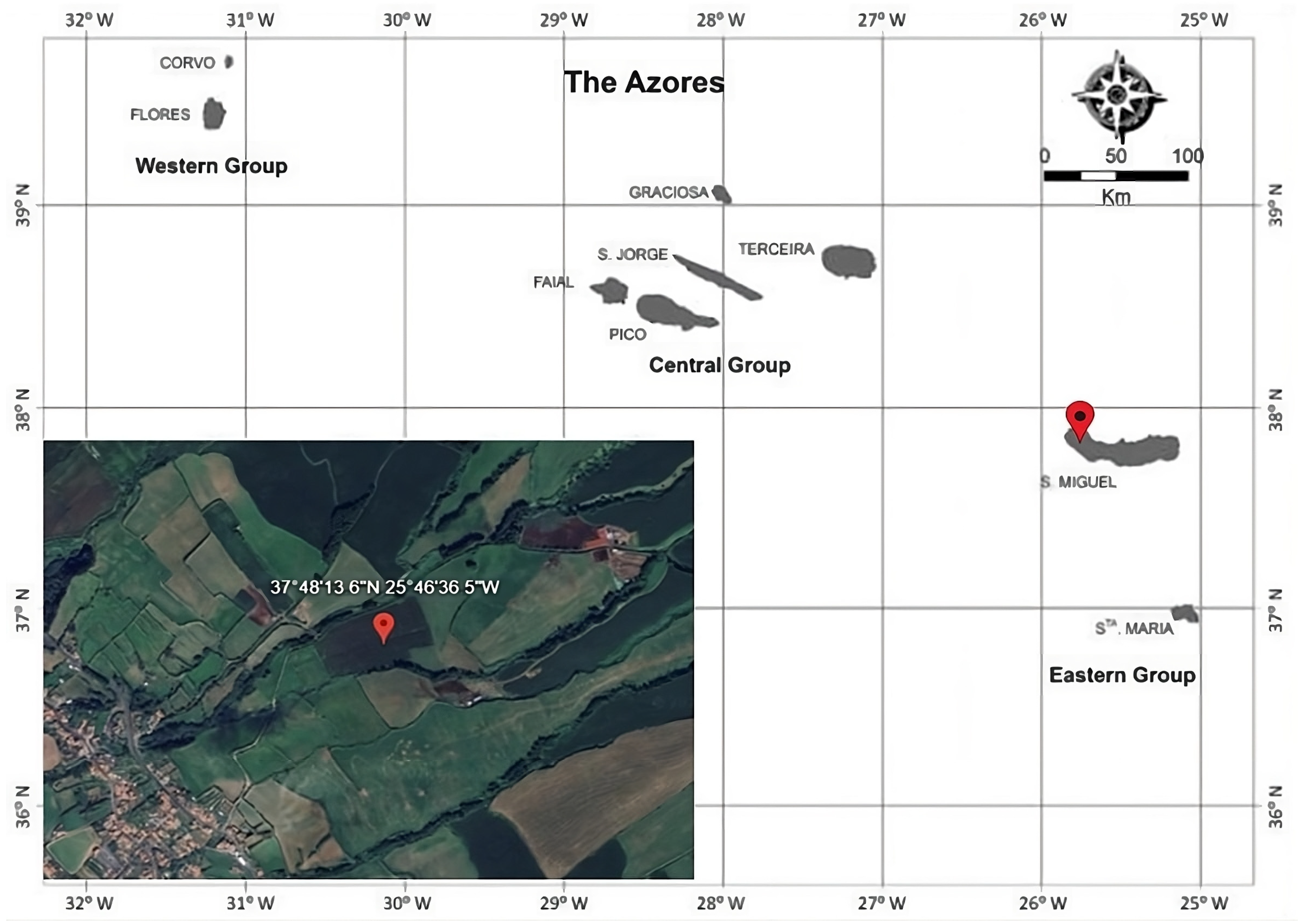
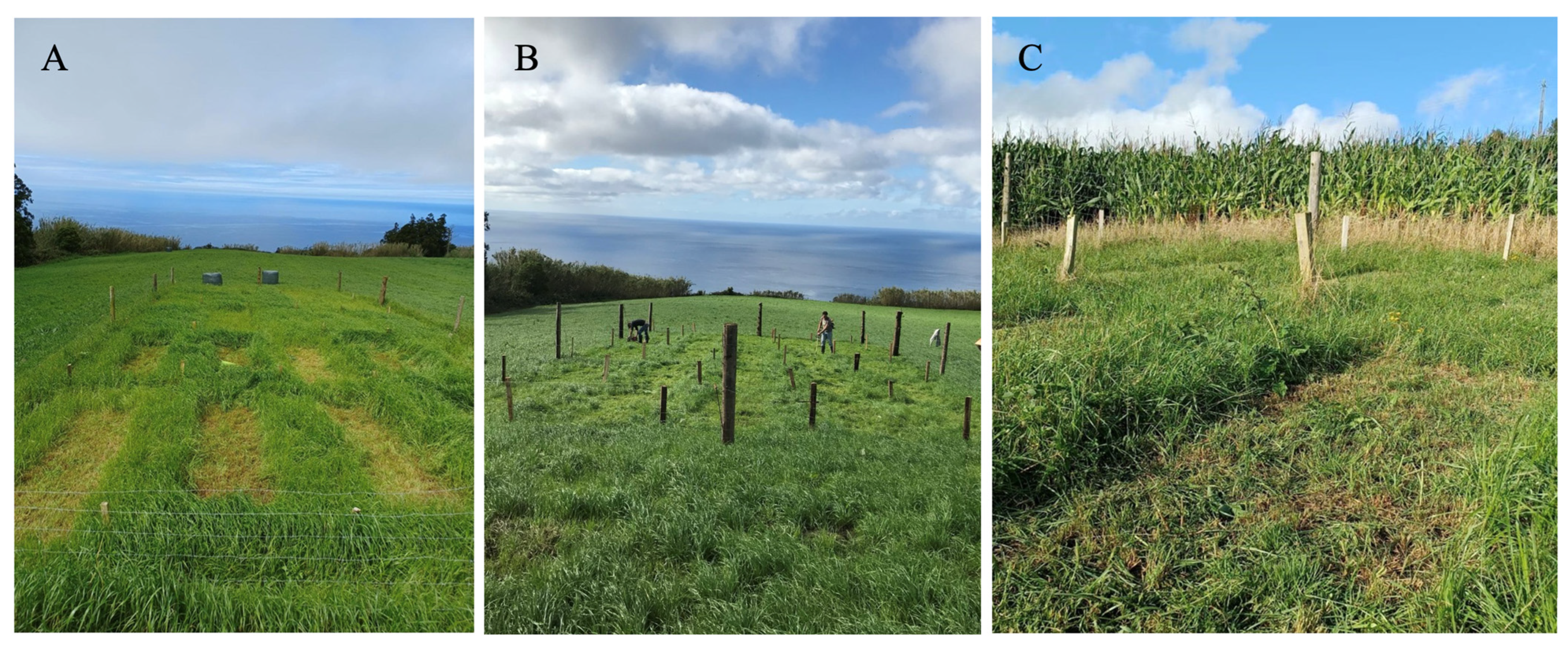
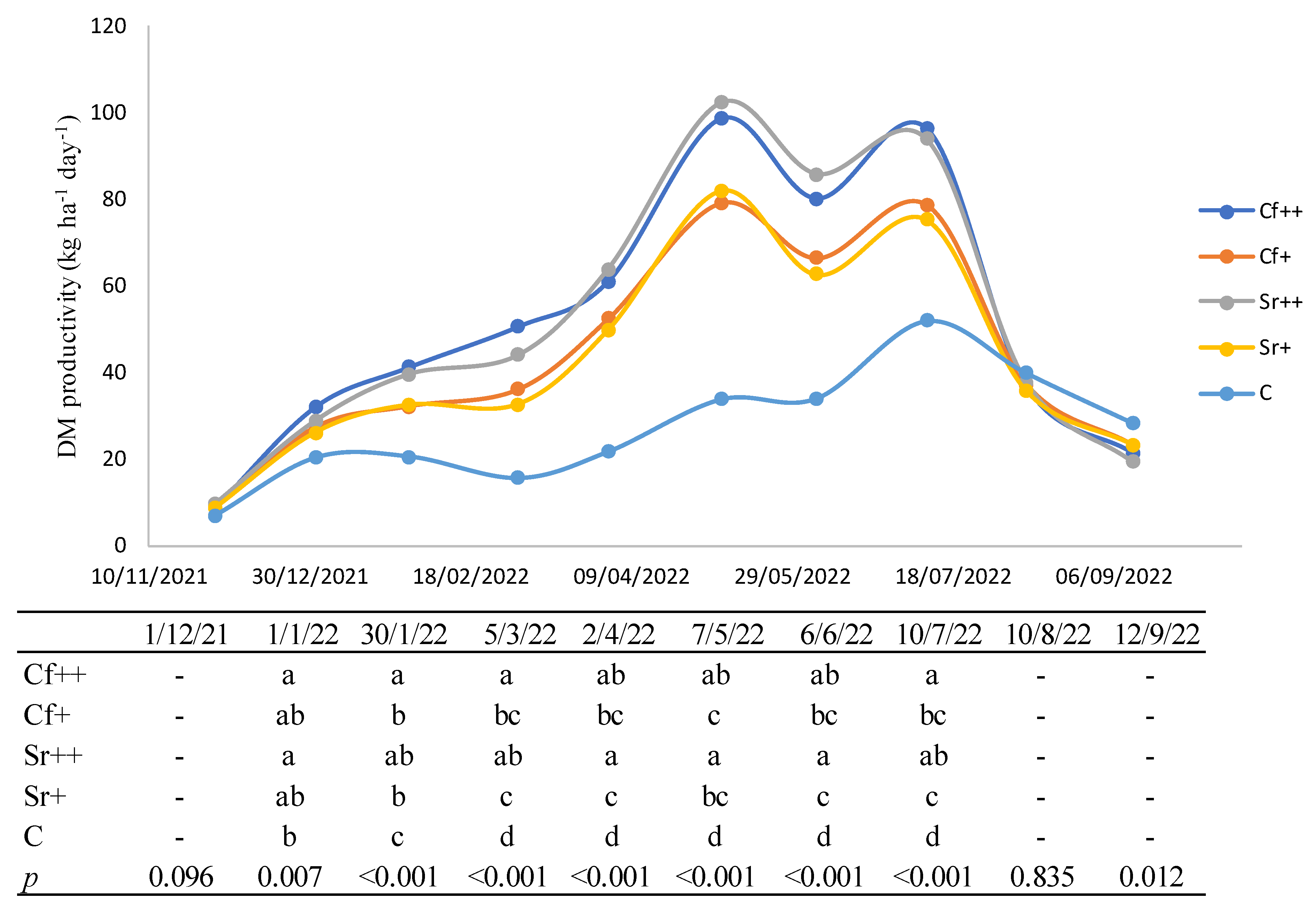

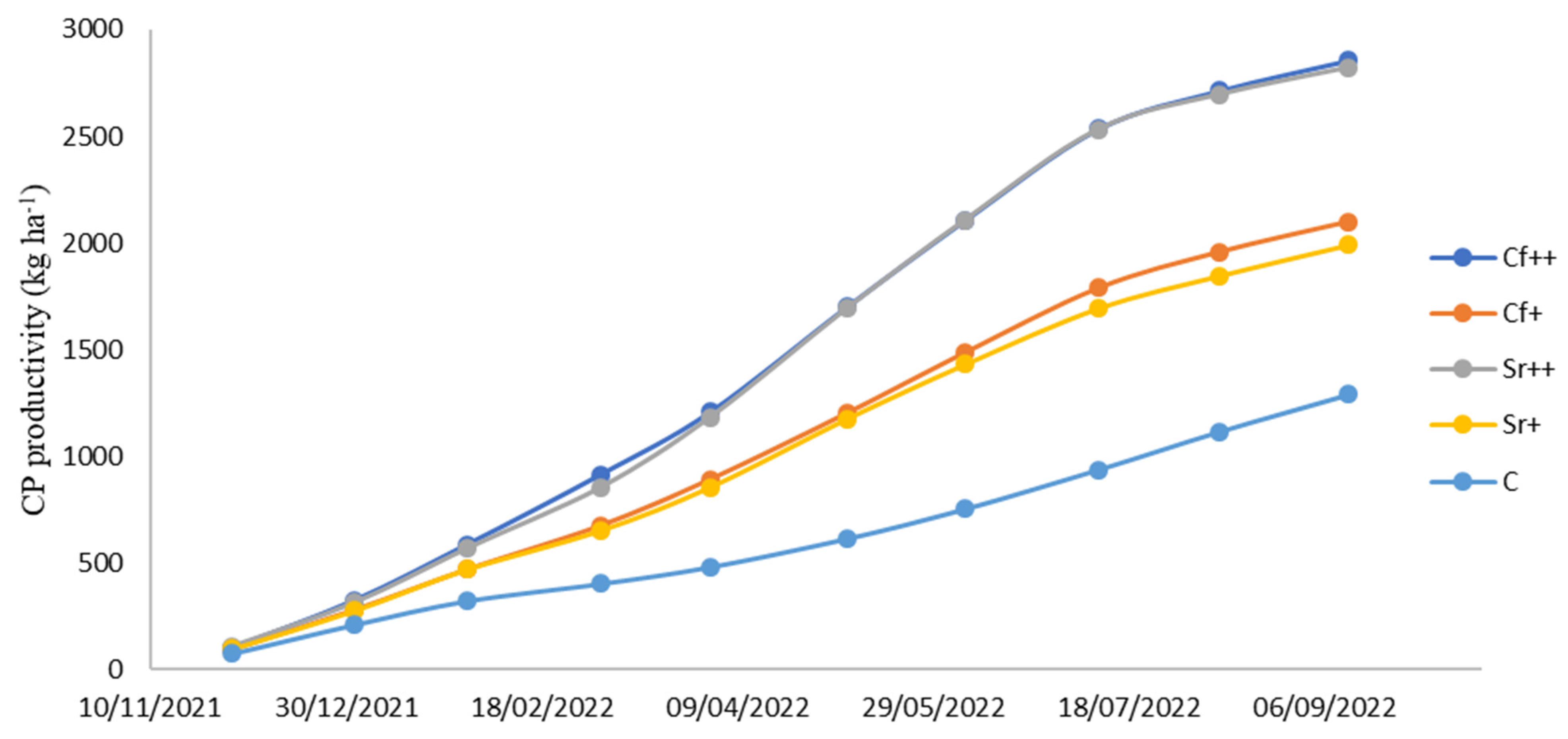
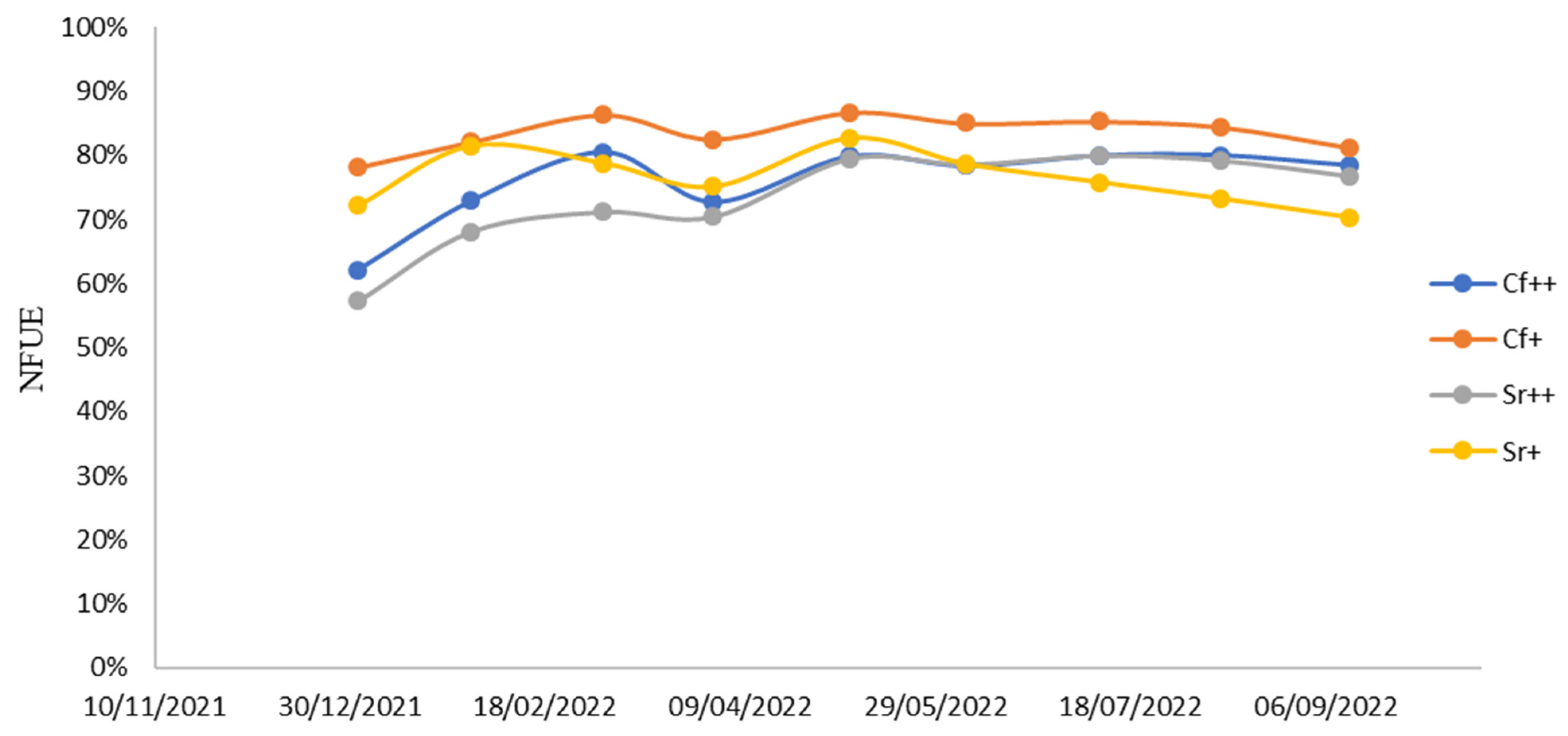
| Harvest | Fertilization | |||
|---|---|---|---|---|
| Cuts | Date | Growing Days | Cf+/Sr+ (kg N ha−1) | Cf++/Sr++ (kg N ha−1) |
| 1st | 1 December 2021 | 54 | 14.53 | 29.05 |
| 2nd | 1 January 2022 | 31 | 14.53 | 29.05 |
| 3rd | 30 January 2022 | 29 | 21.79 | 43.58 |
| 4th | 5 March 2022 | 34 | 29.05 | 58.11 |
| 5th | 2 April 2022 | 28 | 29.05 | 58.11 |
| 6th | 7 May 2022 | 35 | 29.05 | 58.11 |
| 7th | 6 June 2022 | 30 | 21.79 | 43.58 |
| 8th | 10 July 2022 | 34 | ||
| 9th | 10 August 2022 | 31 | ||
| 10th | 12 September 2022 | 33 | ||
| Total | 159.79 | 319.59 | ||
| Date | Treatment | DM (%) | CP (%DM) | NDF (%DM) | ADF (%DM) | ADL (%DM) | CA (%DM) |
|---|---|---|---|---|---|---|---|
| 1 December 2021 | Cf++ | 11.65 ± 0.03 | 20.63 ± 1.14 | 66.99 ± 4.96 | 36.19 ± 2.00 | 5.23 ± 1.50 | 19.62 ± 2.68 |
| Cf+ | 11.93 ± 0.03 | 19.62 ± 1.92 | 70.89 ± 4.01 | 37.32 ± 4.98 | 5.00 ± 1.14 | 20.97 ± 2.67 | |
| Sr++ | 12.33 ± 0.03 | 20.33 ± 1.75 | 68.36 ± 5.03 | 36.88 ± 3.38 | 4.42 ± 1.50 | 20.35 ± 2.94 | |
| Sr+ | 11.96 ± 0.02 | 19.79 ± 1.46 | 67.00 ± 4.09 | 37.79 ± 1.18 | 4.43 ± 0.58 | 22.39 ± 1.89 | |
| C | 11.58 ± 0.01 | 19.50 ± 1.15 | 68.62 ± 7.27 | 36.56 ± 0.95 | 5.07 ± 0.98 | 20.61 ± 2.41 | |
| p | 0.930 | 0.590 | 0.730 | 0.870 | 0.500 | 0.590 | |
| 1 January 2022 | Cf++ | 12.08 ± 0.04 b | 22.30 ± 2.58 | 71.47 ± 5.61 | 35.25 ± 1.17 | 4.00 ± 0.58 | 15.17 ± 2.31 |
| Cf+ | 12.24 ± 0.07 b | 21.82 ± 1.58 | 67.23 ± 3.51 | 33.71 ± 2.66 | 3.59 ± 0.84 | 15.25 ± 0.33 | |
| Sr++ | 11.81 ± 0.03 b | 22.85 ± 0.89 | 68.98 ± 1.77 | 34.02 ± 1.58 | 4.07 ± 0.57 | 15.28 ± 1.33 | |
| Sr+ | 12.28 ± 0.03 b | 22.22 ± 1.35 | 67.40 ± 6.37 | 32.87 ± 1.98 | 4.05 ± 0.77 | 15.36 ± 1.25 | |
| C | 13.65 ± 0.07 a | 21.46 ± 1.12 | 68.07 ± 4.27 | 33.21 ± 2.90 | 3.72 ± 0.92 | 14.66 ± 0.68 | |
| p | 0.004 | 0.383 | 0.216 | 0.206 | 0.714 | 0.835 | |
| 30 January 2022 | Cf++ | 9.37 ± 0.49 | 22.13 ± 1.04 a | 66.01 ± 2.95 | 35.72 ± 5.23 | 3.44 ± 0.47 | 14.79 ± 0.48 |
| Cf+ | 9.01 ± 1.30 | 20.52 ± 1.33 ab | 64.75 ± 3.71 | 37.31 ± 1.36 | 3.44 ± 0.34 | 14.84 ± 0.61 | |
| Sr++ | 9.04 ± 1.28 | 22.32 ± 1.79 a | 65.63 ± 4.24 | 35.09 ± 1.37 | 3.37 ± 0.56 | 13.88 ± 0.81 | |
| Sr+ | 9.80 ± 0.88 | 20.60 ± 1.46 ab | 64.77 ± 2.35 | 34.12 ± 1.35 | 3.6 ± 0.17 | 14.22 ± 0.69 | |
| C | 10.72 ± 0.50 | 18.94 ± 1.09 b | 66.53 ± 3.02 | 32.88 ± 1.67 | 3.34 ± 0.35 | 14.73 ± 0.33 | |
| p | 0.970 | 0.017 | 0.90 | 0.232 | 0.844 | 0.168 | |
| 5 March 2022 | Cf++ | 10.40 ± 1.19 b | 19.00 ± 1.47 a | 74.04 ± 5.08 | 37.38 ± 2.50 | 4.24 ± 0.51 | 13.53 ± 0.71 |
| Cf+ | 10.70 ± 0.65 a | 16.86 ± 2.14 ab | 72.05 ± 1.63 | 35.48 ± 1.25 | 3.90 ± 0.64 | 13.95 ± 0.89 | |
| Sr++ | 9.76 ± 0.46 a | 19.15 ± 1.33 a | 72.93 ± 4.69 | 35.83 ± 2.45 | 4.08 ± 0.67 | 13.59 ± 1.49 | |
| Sr+ | 10.69 ± 0.51 a | 16.39 ± 1.16 b | 76.77 ± 1.83 | 34.67 ± 2.42 | 4.38 ± 0.44 | 13.56 ± 1.27 | |
| C | 12.49 ± 0.87 a | 15.32 ± 0.33 b | 74.16 ± 3.66 | 33.90 ± 2.56 | 4.02 ± 0.38 | 14.50 ± 1.27 | |
| p | 0.003 | 0.002 | 0.164 | 0.231 | 0.561 | 0.380 | |
| Date | Treatment | DM (%) | CP (%DM) | NDF (%DM) | ADF (%DM) | ADL (%DM) | CA (%DM) |
|---|---|---|---|---|---|---|---|
| 2 April 2022 | Cf++ | 12.56 ± 0.45 c | 17.18 ± 1.50 ab | 69.59 ± 5.87 | 32.87 ± 5.43 | 3.70 ± 1.03 | 12.07 ± 0.82 |
| Cf+ | 15.31 ± 1.29 b | 14.86 ± 0.62 bc | 68.69 ± 5.84 | 32.20 ± 2.73 | 3.22 ± 0.97 | 12.08 ± 0.48 | |
| Sr++ | 12.40 ± 1.00 c | 18.41 ± 1.46 a | 69.91 ± 3.95 | 35.16 ± 1.68 | 3.53 ± 0.56 | 11.87 ± 0.98 | |
| Sr+ | 15.42 ± 0.64 b | 14.64 ± 2.58 bc | 68.67 ± 6.73 | 32.91 ± 2.35 | 3.07 ± 0.28 | 11.91 ± 0.24 | |
| C | 19.90 ± 0.94 a | 13.14 ± 0.78 c | 65.16 ± 4.16 | 31.43 ± 2.07 | 3.03 ± 0.50 | 11.79 ± 0.49 | |
| p | <0.001 | 0.001 | 0.705 | 0.354 | 0.479 | 0.943 | |
| 7 May 2022 | Cf++ | 13.29 ± 0.02 c | 14.33 ± 1.29 a | 76.44 ± 3.42 a | 39.31 ± 3.77 a | 4.28 ± 0.43 | 10.13 ± 0.45 b |
| Cf+ | 14.72 ± 0.02 bc | 11.27 ± 1.21 b | 72.91 ± 2.88 ab | 34.97 ± 1.51 bc | 4.53 ± 0.56 | 10.44 ± 0.59 b | |
| Sr++ | 13.61 ± 0.01 c | 14.22 ± 1.64 a | 75.45 ± 2.34 a | 38.44 ± 2.10 ab | 4.43 ± 0.32 | 10.33 ± 0.48 b | |
| Sr+ | 15.60 ± 0.01 b | 11.15 ± 0.79 b | 73.69 ± 1.26 ab | 35.76 ± 2.70 bc | 3.93 ± 0.45 | 9.97 ± 0.45 b | |
| C | 17.93 ± 0.02 a | 11.25 ± 0.86 b | 70.51 ± 3.87 b | 33.18 ± 0.86 c | 3.99 ± 0.72 | 12.05 ± 0.23 a | |
| p | <0.001 | <0.001 | 0.040 | 0.002 | 0.384 | <0.001 | |
| 6 June 2022 | Cf++ | 11.03 ± 0.08 b | 16.78 ± 1.26 a | 77.37 ± 1.22 | 39.03 ± 1.78 | 4.91 ± 0.61 | 11.18 ± 0.89 |
| Cf+ | 11.77 ± 0.06 ab | 14.17 ± 1.39 b | 75.04 ± 4.15 | 37.65 ± 1.55 | 4.71 ± 0.65 | 11.09 ± 0.46 | |
| Sr++ | 11.42 ± 0.03 ab | 16.01 ± 2.02 a | 74.57 ± 2.82 | 39.44 ± 0.33 | 4.36 ± 0.39 | 10.67 ± 0.64 | |
| Sr+ | 12.04 ± 0.04 ab | 13.56 ± 1.05 b | 71.70 ± 4.84 | 37.20 ± 2.79 | 4.67 ± 0.55 | 10.76 ± 0.36 | |
| C | 12.81 ± 0.01 a | 13.57 ± 1.71 b | 72.75 ± 3.00 | 33.94 ± 6.28 | 4.74 ± 1.22 | 11.32 ± 0.46 | |
| p | 0.050 | <0.001 | 0.097 | 0.081 | 0.862 | 0.507 | |
| 10 July 2022 | Cf++ | 21.02 ± 0.01 | 13.07 ± 0.87 a | 71.46 ± 1.34 ab | 35.69 ± 2.36 | 6.93 ± 0.22 | 8.68 ± 0.43 |
| Cf+ | 21.81 ± 0.01 | 11.26 ± 0.63 ab | 71.62 ± 4.03 ab | 36.80 ± 3.63 | 6.65 ± 1.24 | 9.04 ± 0.40 | |
| Sr++ | 20.54 ± 0.01 | 13.34 ± 2.39 a | 72.98 ± 2.03 a | 38.12 ± 0.73 | 5.94 ± 0.80 | 8.74 ± 0.57 | |
| Sr+ | 21.43 ± 0.01 | 10.21 ± 0.50 b | 70.53 ± 2.64 ab | 36.98 ± 2.05 | 5.93 ± 0.90 | 8.99 ± 0.26 | |
| C | 21.97 ± 0.01 | 10.39 ± 0.58 b | 68.48 ± 1.54 b | 37.96 ± 0.77 | 5.41 ± 0.53 | 9.48 ± 0.38 | |
| p | 0.258 | 0.003 | 0.020 | 0.410 | 0.100 | 0.072 | |
| 10 August 2022 | Cf++ | 23.72 ± 0.02 | 15.80 ± 1.15 | 74.61 ± 2.59 | 40.32 ± 1.28 | 10.43 ± 1.12 | 9.80 ± 0.70 |
| Cf+ | 23.61 ± 0.02 | 14.81 ± 0.87 | 74.95 ± 2.22 | 40.00 ± 1.99 | 10.60 ± 0.86 | 9.99 ± 0.46 | |
| Sr++ | 25.52 ± 0.01 | 14.01 ± 0.47 | 72.24 ± 1.63 | 38.71 ± 1.60 | 10.35 ± 0.99 | 9.14 ± 0.50 | |
| Sr+ | 24.28 ± 0.01 | 13.78 ± 0.0.66 | 74.93 ± 1.96 | 40.76 ± 1.08 | 10.83 ± 0.74 | 9.97 ± 0.30 | |
| C | 22.16 ± 0.02 | 14.39 ± 1.15 | 74.59 ± 2.65 | 39.74 ± 0.88 | 10.72 ± 0.90 | 10.40 ± 0.36 | |
| p | 0.100 | 0.056 | 0.378 | 0.156 | 0.956 | 0.097 | |
| 12 September 2022 | Cf++ | 19.13 ± 2.00 | 20.27 ± 1.43 | 68.36 ± 1.99 | 38.19 ± 3.26 | 7.93 ± 0.33 | 11.89 ± 0.55 |
| Cf+ | 18.78 ± 1.37 | 18.54 ± 1.23 | 66.38 ± 1.18 | 38.54 ± 1.11 | 8.13 ± 0.45 | 11.49 ± 0.62 | |
| Sr++ | 21.27 ± 2.65 | 19.72 ± 1.83 | 67.74 ± 4.51 | 36.69 ± 1.46 | 8.09 ± 0.26 | 11.13 ± 1.35 | |
| Sr+ | 21.08 ± 2.06 | 18.74 ± 1.25 | 68.53 ± 2.87 | 38.52 ± 1.36 | 7.96 ± 0.42 | 11.45 ± 1.02 | |
| C | 19.80 ± 1.04 | 18.29 ± 1.60 | 67.93 ± 3.47 | 38.28 ± 1.95 | 8.09 ± 0.56 | 11.24 ± 0.89 | |
| p | 0.052 | 0.273 | 0.693 | 0.672 | 0.924 | 0.503 | |
| Task | Cf++ | Cf+ | Sr++ | Sr+ | C |
|---|---|---|---|---|---|
| Fertilizer | 355.08 EUR | 177.56 EUR | 786.71 EUR | 393.36 EUR | 0.00 EUR |
| Seeds | 114.78 EUR | 114.78 EUR | 114.78 EUR | 114.78 EUR | 114.78 EUR |
| Herbicide (4 L ha−1) | 23.90 EUR | 23.90 EUR | 23.90 EUR | 23.90 EUR | 23.90 EUR |
| Disc harrowing (3×) | 76.01 EUR | 76.01 EUR | 76.01 EUR | 76.01 EUR | 76.01 EUR |
| Fertilizer distribution | 53.59 EUR | 53.59 EUR | 53.59 EUR | 53.59 EUR | 00.00 EUR |
| Seed distribution | 7.66 EUR | 7.66 EUR | 7.66 EUR | 7.66 EUR | 7.66 EUR |
| Spraying | 22.19 EUR | 22.19 EUR | 22.19 EUR | 22.19 EUR | 22.19 EUR |
| Total | 653.21 EUR | 475.68 EUR | 1084.84 EUR | 691.48 EUR | 244.54 EUR |
| Cost (EUR Kg DM−1) | 0.038 c EUR | 0.033 ac EUR | 0.064 a EUR | 0.050 b EUR | 0.028 d EUR |
| Cost (EUR Kg CP−1) | 0.229 b EUR | 0.227 b EUR | 0.384 a EUR | 0.347 a EUR | 0.190 b EUR |
Disclaimer/Publisher’s Note: The statements, opinions and data contained in all publications are solely those of the individual author(s) and contributor(s) and not of MDPI and/or the editor(s). MDPI and/or the editor(s) disclaim responsibility for any injury to people or property resulting from any ideas, methods, instructions or products referred to in the content. |
© 2024 by the authors. Licensee MDPI, Basel, Switzerland. This article is an open access article distributed under the terms and conditions of the Creative Commons Attribution (CC BY) license (https://creativecommons.org/licenses/by/4.0/).
Share and Cite
Maduro Dias, C.; Machado, M.; Nunes, H.; Borba, A.; Madruga, J.; Monjardino, P. Nitrogen Fertilization Using Conventional and Slow-Release Fertilizers at Multiple Levels in Lolium multiflorum Lam. Pastures. Agronomy 2024, 14, 2191. https://doi.org/10.3390/agronomy14102191
Maduro Dias C, Machado M, Nunes H, Borba A, Madruga J, Monjardino P. Nitrogen Fertilization Using Conventional and Slow-Release Fertilizers at Multiple Levels in Lolium multiflorum Lam. Pastures. Agronomy. 2024; 14(10):2191. https://doi.org/10.3390/agronomy14102191
Chicago/Turabian StyleMaduro Dias, Cristiana, Mateus Machado, Hélder Nunes, Alfredo Borba, João Madruga, and Paulo Monjardino. 2024. "Nitrogen Fertilization Using Conventional and Slow-Release Fertilizers at Multiple Levels in Lolium multiflorum Lam. Pastures" Agronomy 14, no. 10: 2191. https://doi.org/10.3390/agronomy14102191






